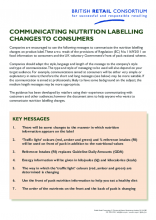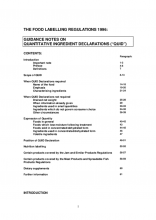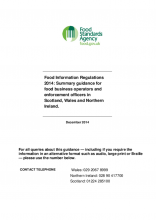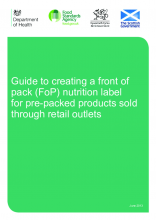Allergens and labelling
New allergen labelling requirements on foods pre-packaged for direct sale (PPDS)
From 1 October, new allergen labelling requirements came into force on foods which are pre-packaged for direct sale (PPDS). This legislation, known as Natasha’s Law, means that most on-the-go foods must now display full ingredients and allergen listing to protect consumers with a food allergy or intolerance. This applies to any food which is packaged on-site where it is being sold and before the customer chooses it, including sandwiches, salads, burgers, pies, and sauces. It is a legal requirement for all food businesses to comply with these rules. Make sure you are aware of the 14 major allergens, which products are covered by the new rules, labelling guidance, and more with the Food Standards Agency (FSA) toolkit.
The Food Information Regulations 2014
The Food Labelling Regulations 1996 have been replaced by The Food Information Regulations 2014 under the Directive of the EU Food Information for Consumer Regulations (1169/2001). Since December 2016 the requirements under the legislation have been in force, including mandatory nutrition declarations for pre-packaged foods.
These new regulations apply to all food businesses supplying food to the public and caterers, including retail premises, manufacturers, restaurants, delicatessens, bakeries, sandwich bars, supermarkets, caterers, take-aways, buffets, and home caterers. There are some exemptions for example private individuals providing food for events such as church, village or school fetes where there is no food business element.
Compliance dates
- 1 January 2014 – For the rules on the composition and labelling of minced meat
- 13 December 2014 – For the general labelling rules, and if provided, a nutrition declaration must use the prescribed format set out from this date
- 13 December 2016 – For the rules on the mandatory nutrition declaration needed for most pre-packaged foods
The essentials
Much of what is detailed in the current Food Labelling Regulations 1996 remains unchanged. There is no change in the fundamental principles of providing safe food which is honestly described and not misleading. In addition foods cannot be labelled to state they will prevent, treat or cure a human disease. The following information must be required in English on pre-packed food labelling:
- a true name or description of the food
- the ingredients it contains, in descending weight order
- how it should be handled, stored, cooked or prepared
- who manufactured, packed or imported it
- origin information if its absence would mislead
- allergenic ingredients identified on the label
- specific information declaring whether the food is irradiated or contains genetically modified material or aspartame, high caffeine, sweeteners, packaging gases etc
- net quantity in grams, kilograms, litres etc
- alcoholic strength where there is more than 1.2% alcohol by volume
Main changes
Allergens
The legislation builds on allergen labelling provisions for prepacked foods and introduces a new requirement for allergen information to be provided for foods sold non-packed or pre-packed for direct sale. Businesses will need to provide information if any of the foods/ingredients that are on the regulatory list and indicated below are used in the preparation of food they supply. Allergen ingredients information is required to be provided in a clearer and more consistent way. For example, any of the 14 allergens that are on the regulatory list are to be emphasised on the label of a pre-packaged food if they are used as ingredients.
|
The 14 ingredients or products thereof causing allergies or intolerances are: Cereals containing gluten (wheat, rye, barley, oats, spelt, kamut), Crustaceans, Molluscs, Eggs, Fish, Peanuts, Soybeans, milk (including lactose), Nuts, Celery, Mustard, Sesame Seeds, Lupin and Sulphur Dioxide and Sulphites (at concentrations of more than 10mg/kg) |
If the food is non-pre-packed such as in a restaurant or café then the information about allergens can be supplied on the menu, on chalk boards, tickets or provided verbally by an appropriate member of staff as well as in other formats made available to the consumer. It must be clear and conspicuous, not hidden away, easily visible, and legible. If the information is to be provided verbally by a member of staff then it is necessary to make it clear that the information can be obtained by asking a member of staff by means of a notice, menu, ticket or label that can easily be seen by customers.
Allergen information must be specific to the food, complete and accurate. This also applies to foods prepacked for direct sale such as from deli counters or sandwich bars.
Refusal to give information, inaccurate or incomplete information about allergenic ingredients used in foods sold non-prepacked or prepacked for direct sale would be a breach of the EU Food Information for Consumers Regulations.
Allergen labelling prepacked food
Allergens listed in the EU Food Information for Consumers Regulations 1169/2011 must be declared in the ingredients list on prepacked food and emphasised through a different font, style etc.
Example of a label indicating ingredients and allergens:
|
Ingredients Figs (35%), barley, flakes, toasted and malted oat flakes (oat flakes, barley malt extract), toasted and malted wheat flakes (wheat, barley malt extract), nuts (8%) (brazil nuts, whole hazelnuts) oat flakes, wheat flakes, sunflower seeds (2%). |
Nutritional Labelling
Food labelling rules to change from 2016
Pre-packed foods
The obligation to provide nutrition information apply from 13 December 2016 when businesses will have to comply with the EU Food Information for Consumers Regulations 1169/2011 nutrition labelling rules. All pre-packed food must be labelled with nutrition information as part of new labelling requirements. Until 12 December 2016 nutrition labelling may be provided on pre-packed products on a voluntary basis. Foods already packaged and labelled under the previous Food Labelling Regulations 1996 may be sold until stocks are exhausted.
Mandatory (back of pack) labelling
The nutrition information must be set in a prescribed format (commonly referred to as ‘back of pack’ or ‘traffic light’ nutrition labelling. Traffic light’ colours (red, amber and green) and % reference intakes (RI) will be used on front of pack in addition to the nutritional values. RI’s replace Guideline Daily Amounts (GDA) for energy and the mandatory nutrients. RI's will also replace ‘recommended daily allowances’ (RDAs), for vitamins and minerals.
Key new requirements
Mandatory nutrition labelling applies to the majority of pre-packed food. The way in which the ‘traffic light’ colours (red, amber and green) are determined is changing and is designed to help consumers see at a glance what is in their food.
- Red means the food or drink is high in a particular nutrient that we should try to cut down on, eat less often or in small amounts.
- Amber means medium, and if a food contains mostly amber you can eat it most of the time.
- Green means low, and the more green lights a label displays the healthier the food choice.
The label also highlights ‘percentage reference intakes’ (formerly known as guideline daily amounts) to show how much fat, saturated fat, salt and sugars, and energy is in a food product.
The mandatory nutrition declaration comprises: energy value (in both kj) and kilocalories (kcal) plus amounts (in grams (g)) of fat, saturates, carbohydrate, sugars, protein and salt. Full nutrition detail should be provided on the back of the pack in line with quantity of certain ingredients as a percentage of the final product (QUID) requirements. For further information see The Food Labelling Regulations 1996.
The way that nutrition information appears on the label has changed, especially on the front of the pack. Certain key nutrition information may be repeated on a voluntary basis on the ‘front of pack’ (principal field of vision).These new rules apply to any food business operator supplying food to the public or mass caterers. Energy information will be given in kilojoules (kJ) and kilocalories (kcals).
Front of pack nutrition information must be in one of the following formats:
- Energy value (kj and kcal) alone; or
- Energy value (kj and kcal) plus amounts (in grams) of fat, saturates, sugars and salt.
Non pre-packed food
There is no requirement for nutrition information to be provided for food sold non-pre-packed. But if provided voluntarily, it must be in one of the following formats:
- The full ‘mandatory’ nutrition declaration (energy value plus amounts of fat, saturates, carbohydrate, sugars, protein and salt);
- Energy value only;
- Energy value plus amounts of fat, saturates, sugars and salt.
Further information
Resources for allergen information
Guidance for creating a front of pack nutrition label
For more detailed information on these Regulations the Food Standards Agency has several useful links:
- Food.gov Allergies and intolerance website
- Food.gov Food Information Regulations 2013
- The Institute of Food Safety Integrity & Protection has lots of information on the Food Information Regulations 2013
- The Anaphylaxis Campaign website has lots of useful information on the Food Information Regulations and allergy requirements:
Last updated: 5 October 2021




